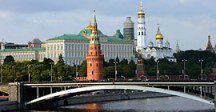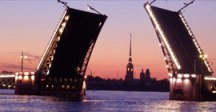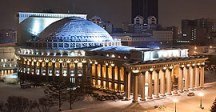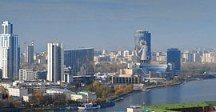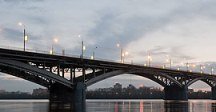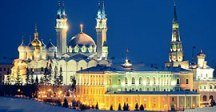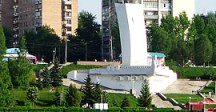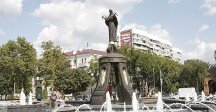Map of Tula
Detailed interactive map of Tula. Map of Tula with streets and numbers of houses. Satellite map of Tula with sights of the city.
The change between the satellite map of Tula and the schematic one is made in the lower left corner of the interactive map.
Tula
Tula city population: 467,955 (2021)
Tula city phone code: +7 4872
Car code of the city Tula: 71
Postal code of the city Tula: 300000-300999
Tula is one of the hero cities of Russia, famous for its Tula gingerbread and weapons. The symbol of the city is undoubtedly the Tula Kremlin, which was built in the 16th century. Once it served as a stone defensive fortress, and today it is the main tourist attraction.
The best and favorite vacation spot for citizens in Tula is the central park of culture and recreation of Belousov, which is valuable for its unique forest area. At one time, such famous personalities as Yesenin, Tolstoy, Veresaev and others strolled along the paths of the park.
What to see in Tula
Diocesan Cathedral of All Saints on Leo Tolstoy Street. After Catherine the Great banned burials in city centers, a cemetery was founded in 1771 on the then outskirts of the city. The Cathedral of All Saints was built for this cemetery between 1773 and 1776 in the classical style. A tall three-tiered bell tower was added in 1825.
Belousov Central Park between Pervomaiskaya Street and Lenin Avenue. The Central Park of Culture and Recreation of Tula is named after the doctor Peter Belousov, who was born and lived in Tula province. It is one of the largest parks in Europe. The park is popular with locals and has several cafes, entertainment and sports facilities, as well as a small beach and a small zoo.
Monument to the Hero City on Victory Square. In 1976, Tula was awarded the title of Hero City of the Soviet Union for the heroism shown during the Second World War. The city was vital for the defense of Moscow.
Monument to Leo Tolstoy. The great writer Leo Tolstoy was born in 1828 in his family estate Yasnaya Polyana, located near Tula. This monument was opened in 1973 and is located at the main entrance to the Central Belousov Park.
The Memorial Museum of Nikolai Beloborodov on Lenin Avenue. Nikolai Beloborodov was born in Tula in 1912 and was an accordionist who developed a special type of accordion (accordion), which became known as Tula Harmony, and organized the world's first accordion orchestra. The Memorial Museum was opened in 1995 in the house of the late 18th century, where Beloborodov once lived. There are some instruments belonging to Beloborodov.
The Church of Saints Peter and Paul on Lenin Street was built between 1833 and 1838 to replace an earlier version of the church. Later, in 1913, a bell tower was added to it.
The Tula Regional Art Museum was opened in 1919 and is one of the largest art galleries in Russia outside Moscow and St. Petersburg. Initially, his collection came from the Chamber of Antiquities, which was founded in 1884. In 1964, the museum moved to its current location. The museum exhibits works by both Western European and Russian masters.
The Vikenty Veresaev House Museum on Gogolevskaya Street is located in the house where Veresaev was born and spent his childhood. Vikenty Veresaev was born as Vikenty Smidovich in Tula in 1867 and was a famous writer and doctor. For his work, he was awarded the Stalin Prize in 1943.
The Church of the Ascension on Herzen Street has been standing on this site since at least 1646, the original version was made of wood.
The Church of the Nativity of the Blessed Virgin Mary was built in the late 18th century and early 19th century to replace the old church that stood here. The single-domed church was built in the classical style using red brick, and its facade is decorated with a pediment and columns.
Monument to Nikita Demidov in Armory Lane. In 1996, a monument dedicated to Nikita Demidov, whose son built the church, was erected at the church of St. Nicholas Zaretsky. Nikita Demidov was the founder of the famous dynasty of gunsmiths.
Tula Exotarium on Oktyabrskaya Street is a zoo for exotic animals, mainly amphibians, turtles, crocodiles, lizards and snakes, as well as some insects, birds and mammals. It was opened in 1987 and has since amassed one of the largest collections of snakes in the world and has achieved some success in breeding programs. There is a statue of a Tyrannosaurus rex outside the exotarium.
Tula Gingerbread Museum on Oktyabrskaya Street. Another product that Tula is famous for is gingerbread with spices - bread, which usually contains a sweet filling. This museum is dedicated to treats and was opened in 1996 in a building that once belonged to the Lyalin family of arms manufacturers and samovars, and is now used to make gingerbread. The museum has exhibitions on how gingerbread is made here, and examples of gingerbread in a wide range of shapes made specifically for various events are presented.
Tula State Museum of Weapons (New building) on Oktyabrskaya Street. The museum was founded in 1724 by order of Emperor Peter the Great to exhibit ancient and rare weapons and in 1984 was moved to the Epiphany Cathedral inside the Tula Kremlin.
The Annunciation Church is the oldest surviving church in the city and dates back to 1692, when it was built with donations, including from the tsars.
The monument to Emperor Peter the Great on Sovetskaya Street was opened in 1912 to commemorate the 200th anniversary of Peter the Great's decree on the establishment of an arms factory in Tula. The statue stands at the administration building of the Tula Arsenal.
The monument to Lefty on Sovetskaya Street in front of the bridge over the Ulu was opened in 2007 and depicts the hero of the story by Nikolai Leskov.
The Tula Regional Museum of Local Lore was opened in 1919 from the collection of the Chamber of Antiquities. It includes exhibitions on archaeology, paleontology, coins, history and nature of the Tula lands. It also presents documents and items related to famous people of Tula.
The Church of St. Elijah the Prophet was built from 1739 to 1760 to replace an older church that once stood here. It consists of a two-storey building with a small dome and a prominent facade in the Russian Renaissance style.
Tula Kremlin. Undoubtedly, the most famous landmark of Tula is the Kremlin of the 16th century, located in the very center of the city. In 1507, Grand Duke Vasily III began to strengthen the city's defenses, as the growing number of Tatar raids from the south made Tula important for the defense of Moscow. Therefore, Vasily III ordered the construction of a wooden fortress on the left bank of the Ula River, which was completed in 1509.
The Museum of Tula Samovars on Mendeleevskaya Street was opened in 1990. It is located in an early 20th century building near the Kremlin and consists of three halls.
The central square of Tula is Lenin Square, which is located outside the Kremlin, between Mendeleevskaya and Sovetskaya Streets. It is here that the main city events and celebrations take place, and, of course, the square is decorated with a statue of Vladimir Lenin.
Porfiry Krylov Museum on Kutuzov Street. Porfiry Krylov was a Soviet artist born in Tula province in 1902. This museum was opened in 1995 in a converted cinema, where more than 250 paintings and watercolors by Krylov are on display. Krylov was especially known for his illustrations and cartoons and was awarded the title of People's Artist of the USSR in 1958. The museum also serves as a center for aesthetic education of children.
The museum-estate of Leo Tolstoy "Yasnaya Polyana" in the Shchekino district. Yasnaya Polyana Manor is the place most associated with the great Russian writer Leo Tolstoy, who was born here, wrote most of his works, died and is buried here.
Sights of Tula
Tula Kremlin, Underground Temple of St. Seraphim of Sarov, Tula Gingerbread Museum, Alexander Nevsky Temple, Tula Exotarium, Demidov Necropolis Museum, Tula Samovars Museum, Assumption Cathedral, Tula Circus, Temple of the Twelve Apostles, All Saints Cathedral, Tula Museum of Fine Arts, Tula State Museum of Weapons, Church of the Annunciation Bogoroditsy, Belousovsky Park, the Art object "Mushroom Meadow", the House Museum of V.V.Veresaev, the Mansion of M. G. Belolipetsky, the Museum and Railway Station Complex "Kozlova Zaseka", the Museum and Exhibition Center "Tula Antiquities".
The largest cities in Russia:
2024 © Russia-Karta.ru
